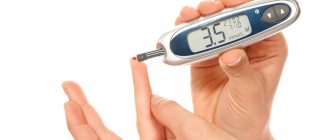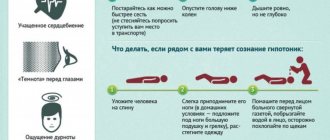The level of hemoglobin in the blood is one of the most important indicators of health, on which the saturation of the body’s cells with oxygen, necessary for metabolic processes, depends. When hemoglobin decreases, weakness, loss of strength, regular headaches and dizziness occur, so it is very important to monitor its level at home.
The importance of determining hemoglobin levels
Hemoglobin is an iron-containing protein found in red blood cells. It performs an extremely important function, ensuring the delivery of oxygen entering the blood to the tissues and cells of the internal organs.
When hemoglobin levels drop rapidly, cells do not receive enough oxygen, which negatively affects the functioning of the entire body.
The protein compound captures oxygen in the lung tissues and transports it to the body’s cells, ensuring their full functioning. Hemoglobin also captures and removes carbon dioxide from the body, which is a waste product.
Carbon dioxide accumulates in tissues, which leads to a deterioration in overall health and the development of such unpleasant symptoms as severe headaches, weakness, loss of strength, and pale skin. It is very important to promptly detect a decrease in hemoglobin and begin treatment. In its absence, complications such as a weakened immune system, tissue hypoxia, chronic insomnia, and heart failure may develop.
When choosing treatments for Covid, it is necessary to focus on the severity of the disease and the clinical situation. A well-designed therapeutic regimen can not only significantly speed up recovery, but also avoid the negative consequences of a dangerous infection. Read more in the article: “Covid treatment at home: drugs.”
Hemoglobin norm depending on age
The normal level of iron-containing protein depends on several factors. It differs radically depending on the age and gender of a person. Before determining the amount of iron-containing protein in the blood, you need to familiarize yourself with the generally accepted reference values for this indicator.
- middle-aged men - 120-160 g/l;
- middle-aged women - 110-140 g/l;
- children under 6 months - 140-220 g/l;
- children from 6 months to 18 years - 95-140 g/l.
A decrease in hemoglobin levels below critical levels is called iron deficiency anemia and requires treatment. Correction of healthy protein levels can be carried out using medications containing iron or following a special diet.
To verify the reduced value, it is advisable to repeat the home measurement several times.
If all the results indicate a pathologically low level of hemoglobin, you should definitely consult a physician, since anemia can have dangerous consequences for the human body.
If a patient shows signs of an infectious-inflammatory process, it is necessary to find out the cause in a timely manner in order to begin treatment. Laboratory and instrumental tests are carried out to identify the pathogen and the state of the body. Read more in the article: “how to find out if there is an infection in the body.”
What is the problem?
For a device to be useful, it must not just be on the shelf, but used correctly. It happens that a person, wanting to save test strips, tries to rely on his own health to assess his sugar level. However, rarely can anyone feel fluctuations in sugar levels of 4-13 mmol/l, and most of the indicators are in these numbers. Even worse, a person who is accustomed to high glycemic levels feels relatively normal, and perceives a decrease in numbers to the correct values as a deterioration in well-being. This means you can’t rely on sensations.
Old age, decreased visual acuity, the presence of mental illness, dementia, rare visits to the doctor, all this reduces the effectiveness of self-control. Many people think that while in the hospital for the selection or correction of treatment, it is necessary to frequently measure the glucose level, but at home you can measure the blood glucose level in the morning after waking up and that is enough. Blood glucose should be measured on an empty stomach, before and after meals.
For type 1 diabetes mellitus, glucose is measured at least 4 times daily, sometimes adding 1 nightly measurement every 3 hours.
In type 2 diabetes mellitus, after diagnosis and during decompensation of the disease, measurements are taken several times a day. The frequency of monitoring is then determined by the type of treatment and the doctor.
The frequency of blood sugar monitoring is determined by the type of treatment and your doctor.
The American Diabetes Association recommends frequent blood glucose monitoring:
- pregnant women;
- people with unstable indicators, prone to severe forms of ketosis or hypoglycemia;
- receiving intensive insulin treatment;
- those who cannot recognize the symptoms of impending hypoglycemia in time;
- if the renal threshold for glucose is violated.
Then it is recommended to measure sugar 6-8 times a day, and if necessary, then at night.
Unfortunately, daily self-measuring of glucose seems to be an unpleasant and worrying procedure. You need to prick your finger yourself, apply the blood correctly to the test strip, and not spoil it. The complexity of operating the device and the price of test strips outweigh the recommendations of the attending physician. Then a situation is created where there is a device, or even more than one, but there is no control.
If you still want to take control of your sugar levels, then you should understand glucometers.
Reasons for decreased hemoglobin
Hemoglobin in the blood can decrease for various reasons. Among the main factors that can provoke a lack of iron-containing protein, doctors identify:
Advertising:
- unbalanced diet with insufficient amounts of foods containing iron;
- excessively heavy or prolonged periods;
- abortion, childbirth or surgery accompanied by significant blood loss;
- hemorrhoids with bleeding;
- following a strict diet or fasting;
- diseases of the hematopoietic system;
- disruption of the absorption of iron in the intestinal cavity;
- lack of vitamin B12, necessary for the formation of hemoglobin in the body.
Common causes of iron deficiency anemia are diseases of the digestive system - chronic enteritis or atrophic gastritis, leukemia, benign or malignant neoplasms in the body.
The causes of a rapid decrease in hemoglobin levels can also be autoimmune and long-term infectious diseases - rheumatoid arthritis, systemic lupus erythematosus, tuberculosis, pneumonia, hepatitis. Many factors can cause the development of anemia; the exact cause can only be determined after a medical examination.
Causes of high and low hemoglobin levels
An increased hemoglobin level in women negatively affects the consistency of the blood (it becomes thicker), as a result of which movement slows down and the cells do not receive oxygen. If you do not respond to an increase in hemoglobin in time, blood clots form in the vessels. An increase in the indicator may be due to various diseases, such as: intestinal obstruction; diseases of the cardiovascular system; blood diseases (leukemia).
A high rate can also indicate various physiological changes and disorders, such as: excessive physical activity, living in high altitudes; hemoconcentration (blood thickening), caused by dehydration of the body - dehydration, or extensive burns. In such cases, the hemoglobin level, after eliminating these causes, returns to normal over time. Symptoms indicating an increase in hemoglobin include: deterioration of brain function; decreased performance; lack of concentration; fatigue; drowsiness or insomnia; lack of appetite; excessive irritability. If these symptoms appear, you should consult a doctor.
In men, an increase in hemoglobin levels can also be associated with smoking, intense training, physical activity and severe stress. Signs of high hemoglobin in men are:
- increased fatigue;
- frequent headaches;
- dizziness, fainting;
- drowsiness;
- loss of appetite.
This symptomatology is characteristic of a number of diseases: respiratory and heart failure; polycystic kidney disease; erythremia. The amount of hemoglobin in the blood may fluctuate due to severe dehydration.
The causes of low hemoglobin can be: anemia of various origins, including those caused by various diseases; impaired blood circulation; thyroid diseases; strict dietary nutrition; emotional fatigue; alcoholism.
Determination of hemoglobin using the device
Today in the pharmacy chain you can find a wide selection of special devices designed to measure hemoglobin levels at home. Such a device is called a hemoglobinometer and is produced by several pharmacological companies.
Some of the most popular devices are MiniGem 540 and Easy Touch. Such hemoglobinometers allow you to determine protein levels in 10 seconds. Technique for performing home analysis:
Advertising:
- using a special needle from the set, pierce your finger;
- drop a few drops of blood into a test tube;
- add hydrochloric acid (included with the device);
- pour distilled water into the device - the liquid should take on the scarlet hue of blood;
- evaluate the result obtained on a special scale and compare it with the presented age norms.
The results of the study will be reliable only if you properly prepare for the procedure yourself. To do this, you must avoid any food or drink for at least 12 hours, and also stop taking any medications.
Complexes with this research
Risk of severe COVID-19 Diagnosis of prediabetes and blood clotting disorders 710 R Composition
Advanced anti-aging diagnostics in postmenopause Extended monitoring of age-related changes during postmenopause 21,510 R Composition
Women's check-up No. 1 38 studies for annual preventive examination RUB 13,990 Composition
IN OTHER COMPLEXES
- Monitoring the diet of a nursing mother RUB 2,060
- Advanced women's anti-aging diagnostics RUR 21,130
- Men's check-up No. 1 12,740 RUR
- Cola and chips RUR 2,170
- For those at risk of COVID-19 RUB 2,880
Hemoglobin measurement with portable rapid tests
To measure hemoglobin levels at home, you can use simple and convenient test strips. Many manufacturers offer functional portable blood analyzers that measure not only iron protein levels, but also blood sugar and cholesterol. To do this you need to follow a few simple steps:
- wash your hands thoroughly;
- sit down and try to relax;
- Shake your hand for 2-3 seconds to activate blood circulation in your hand;
- lubricate your finger with alcohol;
- install the test strip with a connector specially designated for it - the device turns on in automatic mode;
- The device comes with a special pen with a needle, with which you need to puncture the treated finger;
- Apply a drop of blood from your finger to the control field of the strip.
Within a few seconds, information about the level of hemoglobin in the blood will appear on the device monitor. Many such devices are equipped with an electronic memory function, which allows them to record the obtained analysis result.
How to test hemoglobin in blood in the laboratory
To check hemoglobin in the blood, you need to donate blood from a vein or finger to the laboratory for a general (general clinical) blood test. It is performed in a shortened or expanded version (with a leukocyte formula); both are suitable for studying the content of red blood cells and hemoglobin protein.
There is a peculiarity of the study if the presence of abnormal forms of hemoglobin is suspected (hemoglobinopathies, thalassemia, drug poisoning, hemolytic anemia). In such cases, the doctor prescribes a special test - electrophoresis of hemoglobin fractions. It is based on the separation of normal and abnormal proteins using electrical current.
Main symptoms of iron deficiency anemia
Advertising:
You can determine a low hemoglobin level yourself, without special equipment. To do this, you need to pay attention to the characteristic signs that may indicate the development of iron deficiency anemia. The main manifestations of low hemoglobin:
- headaches accompanied by dizziness or fainting;
- noise in ears;
- pale or yellowing of the skin of the face and body;
- lethargy, weakness, loss of strength;
- loss of appetite;
- muscle pain;
- decreased immunity and frequent colds;
- cold extremities;
- change in taste preferences - the desire to eat chalk, raw dough, eggshells.
Iron deficiency anemia is accompanied by a decrease in blood pressure, constant shortness of breath, rapid heartbeat, and heart rhythm disturbances. Also, a decrease in iron-containing protein in the blood leads to indigestion, changes in the color and consistency of stool. A lack of hemoglobin can also be detected by a person’s appearance. His skin becomes dry, acquires a jaundiced or pale tint, the conjunctiva of the eyes turns red, hair and nails become brittle, and their growth slows down.
Electrochemical glucometers
Their action is based on the amperometric method of analysis. The test strips here are also lubricated with a reagent, but when they come into contact with blood, coloring does not occur. During the reaction, electric current is released. Its strength depends on the sugar level.
Electrochemical devices eliminate a number of disadvantages of photometric devices:
- increased strength;
- the accuracy of measurements has been increased (current strength is a specific value, as opposed to color);
- the required amount of blood for analysis has been reduced.
A child, an elderly person or simply a person with a low pain threshold will definitely prefer this type of sugar meter. The depth of the puncture depends on the required volume of blood. If less is required, the procedure is less painful.
Proper nutrition to increase hemoglobin
Advertising:
If your hemoglobin level is low, you should include as many iron-containing foods as possible in your diet.
| Healthy foods | Variety |
| Meat and offal | Beef, chicken, beef liver, tongue |
| Cereals | Buckwheat |
| Fish and seafood | Red fish, red caviar, shrimp, crabs, mussels, oysters, kelp |
| Eggs | Egg yolk |
| Fruits | Pomegranate, feijoa, plum, persimmon, apples, bananas, apricots, peaches |
| Berries | Cranberries, wild strawberries, raspberries, strawberries, blueberries, black currants, rose hips |
| Vegetables | Beets, carrots, beans, lentils, peas, pumpkin, tomatoes, potatoes, onions |
Various dried fruits can be an effective way to quickly increase hemoglobin at home. Raisins, apricots, and dried apricots contain a significantly higher concentration of iron than fresh fruits.
Consequences of low hemoglobin
Advertising:
Decreased immunity is a dangerous condition that cannot be ignored. It is accompanied by a serious deterioration in general well-being - a person is bothered by regular headaches, weakness, lethargy and loss of strength. In severe forms of iron deficiency anemia, severe dizziness and fainting may occur, attention disturbances, increased fatigue and muscle relaxation are often observed, which at an advanced stage can lead to urinary incontinence.
A decrease in hemoglobin below critical levels negatively affects not only a person’s well-being, but also his appearance.
As a result of lack of oxygen, skin, hair and nails dry out and become thinner, becoming dull and faded.
If iron-containing protein falls below normal, this negatively affects the immune system. As a result, a person is bothered by regular colds, as well as exacerbations of chronic diseases.
A few words about the role of hemoglobin
The hemoglobin level plays a very important role in the full functioning of the human body. This iron-containing protein supplies oxygen to the cells and tissues of internal organs, ensuring their normal functioning.
You can increase your hemoglobin level if it decreases with the help of a proper, balanced diet. Additionally, you can take pharmaceutical iron supplements, which will be prescribed by your doctor based on the results of a blood test.
Is it possible to take blood from something other than a finger?
Traditionally, blood for testing is taken from a finger or from a vein. In the case of assessing sugar levels, venous is not very preferable. It contains more glucose than capillary, and there is a high risk of incorrect interpretation of the analysis. Therefore, blood for sugar is taken from a finger.
But there are many nerve endings in the fingertip. For many people, piercing is too painful. Therefore, there are high-quality glucometers that include the ability to analyze blood from:
- shoulder;
- forearms;
- shins;
- hips.
It's not that painful to pierce them. However, blood circulation in these parts of the body is slower than in the fingers. Therefore, changes in glucose levels do not always appear in a timely manner according to analyzes from alternative sites.











